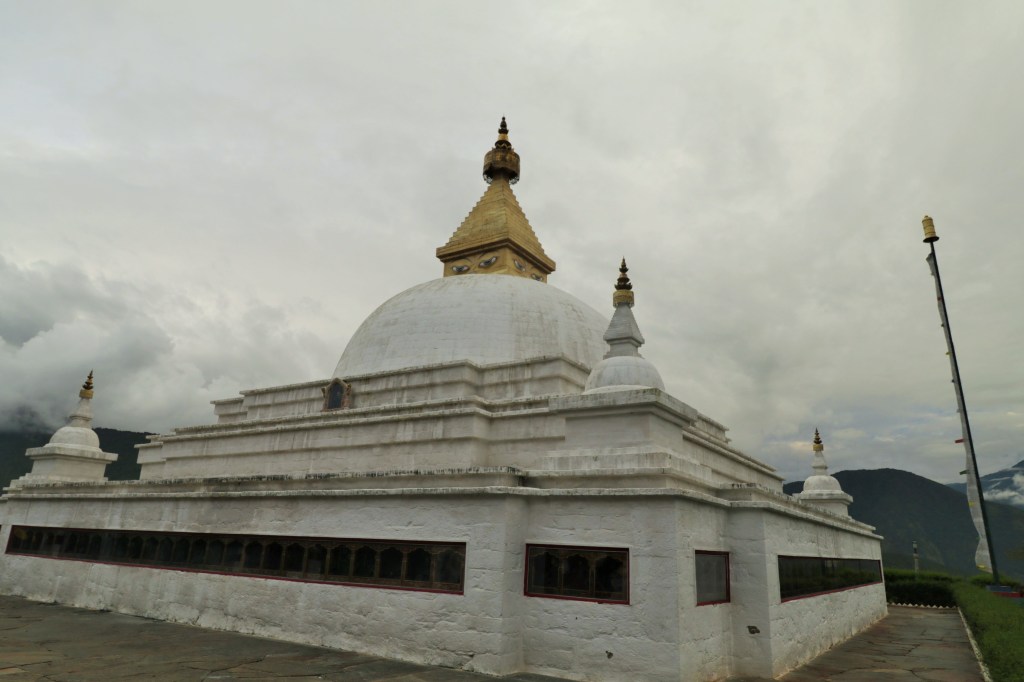Sangchhen Dorji Lhuendrup Lhakhang Nunnery
Once upon a time and not so long ago, a very young King in the mystical Himalayan mountains discovered that he was the fulfillment of a 300 year-old prophecy. His destiny was to reunite and bring his country into the modern world. Being a descendant of the ancient and powerful Dorji family in mind and speech, he is the incarnation of a great holy man, Ngawang Namgyal (1594-1651).
Others held claim to the title too. The best way to unify a land is to marry into the other contenders with provenance. So the fourth king, Jigme Sungye Wangchuck married all four sisters from the opposing powerful family.

prayer wheel on the summit of the hill overlooking a narrow valley
The father of the four sisters ( also a Dorji family member) asked the king for land to build a Buddhist nun’s university on the highest scenic hill above the Punaka valley in Bhutan. The official name–Sangchhen Dorji Lhuendrup Lhakhang Nunnery means, “Fortress of the heap of Jewels.” The young ladies here are treasures far more precious than diamonds or pearls.
The four queen’s parents have their homestead on this hill too, situated a wee bit lower, giving the nuns and religion the best position for grace and inspiration.
We visited many Buddhist landmarks and saw countless beautiful artifacts. Religious festivals with dance and music enriched our experiences. Listening to monks chant in the temple hit an inner cord of my soul. But the visit here touched my heart in deeper ways than any other place in Bhutan.
Give me one giggling nun willing to express her thoughts and beliefs any day over all the pomp and circumstance.
Laughter. This was the first thing different in the nunnery compared to a monastery. These girls look and act happy.
They wanted to talk to us, to explain with eloquence and passion why they decided to become nuns or what they’re daily life is like. They study and pray. There are also classes in tailoring, embroidery, statue making, painting and ceremonial dancing. When they graduate from their studies they will go to other communities to support a religious life. One girl told me, “It’s very important that I pray for every living thing, every day.” They are dedicated to their mission of salvation. 
curiosity. They also wanted to know about us and how we live. In my experience, the monks could have cared less. (Of course a woman cannot touch a monk. If I would have wanted to give an item, I’d have to pass it to a man who would then give it to the monk. )
Only monks can perform religious ceremonies and are paid for services. The nuns are supported with a stipend per month. Their parents may receive a spit of land to grow rice.
Sure, there are interesting architectural components to view here. A chorten (monument) that looks like a smaller Boudhanath Stupa sits at the point of the hill with stunning views into two narrow valleys.
The UNESCO site in Nepal is the largest stupa in the world, a place of great pilgrimage and was built by a mother of poor status who petitioned her king. It’s fitting that this replica is a reminder to the young nuns of the strength within their hands and minds. It signifies the deep power within each woman.
Walk into the temple, under the crystal chandeliers to see statues of important rampoches’. It’s impressive. But nothing compares with the beautiful spirit and promise for a rich future unfolding for the women here.





